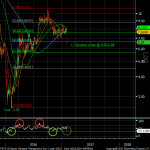There was a potentially important development in inflation recently, but one that was generally overlooked.
Perhaps it was mostly overlooked because it is way too early to say that a trend is developed that could cause an adverse inflation occurrence. But I think that the main reason it was overlooked is that monetary velocity is not very well understood. In particular, most people seem to think that money velocity – definitionally, the number of times a unit of money is transacted in a year, on average – is somehow tied to nervousness about the economy. So, when money velocity fell in the global financial crisis, many observers attributed that to savers stuffing dollar bills in the proverbial mattress.
There may be some role for investor/consumer uncertainty in the modeling of velocity, but at best it is a secondary or tertiary cause. The main cause of changes in velocity is simple: when the cost of holding money is high, we work hard to hold less of it, and when the cost of holding money is low, we don’t mind holding more of it. Friedman first noticed this, so it isn’t a new discovery. In monetarist speak, velocity is the “inverse of the demand for real cash balances,” and the demand for such balances depends of course on the relative cost of cash balances relative to other investments.
The chart below shows the power of this relationship. I’m using the 5-year constant maturity treasury rate, but there are obviously other investments that would get thrown into this relationship. But it’s easy to envision the effect here. When interest rates are at 6%, then money does not sit idle for very long or accumulate without limit in your bank account – you will invest those monies in, say, a 5-year CD or Treasury Note, rather than earn basically nothing in a checking account. But when interest rates are at 1%, the urge to do so isn’t as much.

What you can see in the chart is that interest rate moves tend to precede movements in money velocity, which is what we would expect from a causal relationship such as this. So the reason that money velocity plunged in the GFC wasn’t because people were scared; it was mostly because interest rates fell, taking away the incentive to invest longer-term.

















Leave A Comment